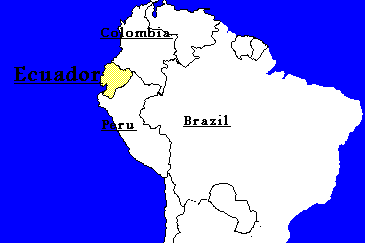
Return to * Top Ten *RIC Main Page * Background Info
Ecuador
Background Information

Basic Indicators
| Population | 11,200,000 |
| Population growth | 2.19% per annum |
| Land area | 276,840 sq km |
| Life Expectancy | 69.3 years |
| GNP per capita | 1280 current US$ |
| Literacy | 90% |
ENVIRONMENT
The country is divided into three natural regions: the coast, the mountains and the rainforest. Due to the influence of the cold Humboldt current, the climate of the coastal region is mild. More than half of the population lives along the coast, where cash crops of bananas, cocoa, rice and coffee are grown. In the highlands, extending between two separate ranges of the Andes, the climate varies according to altitude, and subsistence crops are grown. In the eastern Amazon region, recent oil finds supply internal demand, leaving a small surplus for export. The Colón or Galapagos archipelago belongs to Ecuador. The country also lays claim to 200,000 sq km of Amazon territory presently controlled by Peru, as well as the air space over its territory, where communication satellites are stationed. In the coastal region, 95% of the woodlands have been felled. Soil depletion has increased by 30% over the past 25 years.
SOCIETY
Peoples: Most Ecuadoreans are descended from the Quechua people who made up the kingdom of Quito. A break-down of the current population shows a high percentage of mestizos, the result of intermarriage with the Spaniards and their descendents, in addition to descendents of African slaves. There are nine indigenous nationalities: Huaorani, Shuar, Achar, Siona-Secoya, Cofan, Quechua, Tsachila and Chachi. There are over 1.5 million Quechua living in the inter-Andean valley. Religions: Mainly Catholic. Languages: Spanish (official), although 40% of the population speaks Quechua. Political Parties: The Social Christian Party of Jaime Nebot; the United Republican Party, conservative; the Ecuadorean Roldosista Party; the Democratic Left, social democratic, affiliated to the Socialist International; the Conservative Party; Peoples Democracy; the Christian Democratic Union; the Democratic Peoples Movement; the Ecuadorean Socialist Party; the Concentration of Popular Forces; the Radical Liberal Party; the Broad Front of the Left; the Radical Alfarista Front; the National Patriotic Front, of Frank Vargas; the Ecuadorean Peoples Revolutionary Action; the National Liberation Party. Social Organizations: The major union federations are the Ecuadorean Central Organization of Class Unions (CEDOC), and the Central Organization of Ecuadorean Workers (CTE) coordinated with the United Workers Front (FUT). In the last few years the Confederation of Indigenous Nationalities of Ecuador (CONAIE) has gained importance; the National Federation of Small Producers (FNPA).
THE STATE
Official Name: República del Ecuador. Administrative divisions: 21 Provinces. Capital: Quito, 1,420,000 inhab. (1992). Other cities: Guayaquil, 1,950,000; Cuenca, 325,000 inhab. (1992). Government: Abdala Bucaram, President since August 1996. The constitution approved by plebiscite in 1978 established a presidential system and granted the right to vote to illiterate people for the first time in 1984. National Holiday: August 10, Independence Day (1809). Armed Forces: 58,000 troops (conscripts). 100,000 reserves (1993). Paramilitaries: 200 Coast Guard and 6 coastal patrol units (1993).
Source: World Guide 1997/98 courtesy of New Internationalist ![]()
Return to * Top Ten *RIC Main Page * Background Info